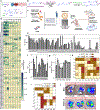Combinatorial design of nanoparticles for pulmonary mRNA delivery and genome editing
- PMID: 36997680
- PMCID: PMC10544676
- DOI: 10.1038/s41587-023-01679-x
Combinatorial design of nanoparticles for pulmonary mRNA delivery and genome editing
Abstract
The expanding applications of nonviral genomic medicines in the lung remain restricted by delivery challenges. Here, leveraging a high-throughput platform, we synthesize and screen a combinatorial library of biodegradable ionizable lipids to build inhalable delivery vehicles for messenger RNA and CRISPR-Cas9 gene editors. Lead lipid nanoparticles are amenable for repeated intratracheal dosing and could achieve efficient gene editing in lung epithelium, providing avenues for gene therapy of congenital lung diseases.
© 2023. The Author(s), under exclusive licence to Springer Nature America, Inc.
Conflict of interest statement
Competing interests: B.L., R.S.M., A.G. and D.A. have filed a patent (PCT/US2022/052314) for development of the described lipids. D.A. receives research funding from Translate Bio and is a Founder of Orna Therapeutics. R.L. is a cofounder of Moderna; he also serves on the board and has equity in Particles for Humanity. For a list of entities with which R.L. is, or has been, recently involved, compensated or uncompensated, see https://www.dropbox.com/s/yc3xqb5s8s94v7x/Rev%20Langer%20COI.pdf?dl=0 . The other authors declare no competing interests.
Figures


References
-
- Rudnick DA & Perlmutter DH Alpha-1-antitrypsin deficiency: a new paradigm for hepatocellular carcinoma in genetic liver disease. Hepatology 42, 514–521 (2005). - PubMed
-
- Riordan JR et al. Identification of the cystic fibrosis gene: cloning and characterization of complementary DNA. Science 245, 1066–1073 (1989). - PubMed
-
- Wan T & Ping Y Delivery of genome-editing biomacromolecules for treatment of lung genetic disorders. Advanced Drug Delivery Reviews 168, 196–216 (2021). - PubMed
MeSH terms
Substances
Grants and funding
LinkOut - more resources
Full Text Sources
Other Literature Sources
Molecular Biology Databases

